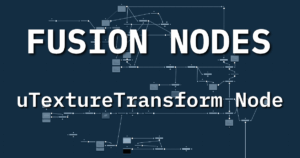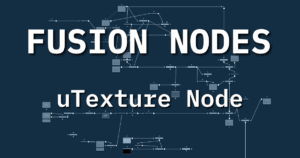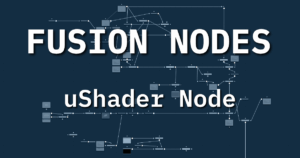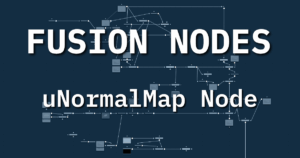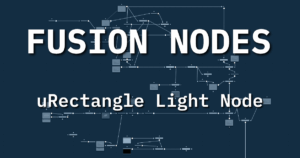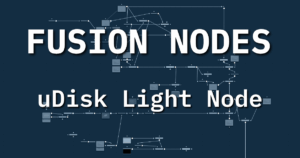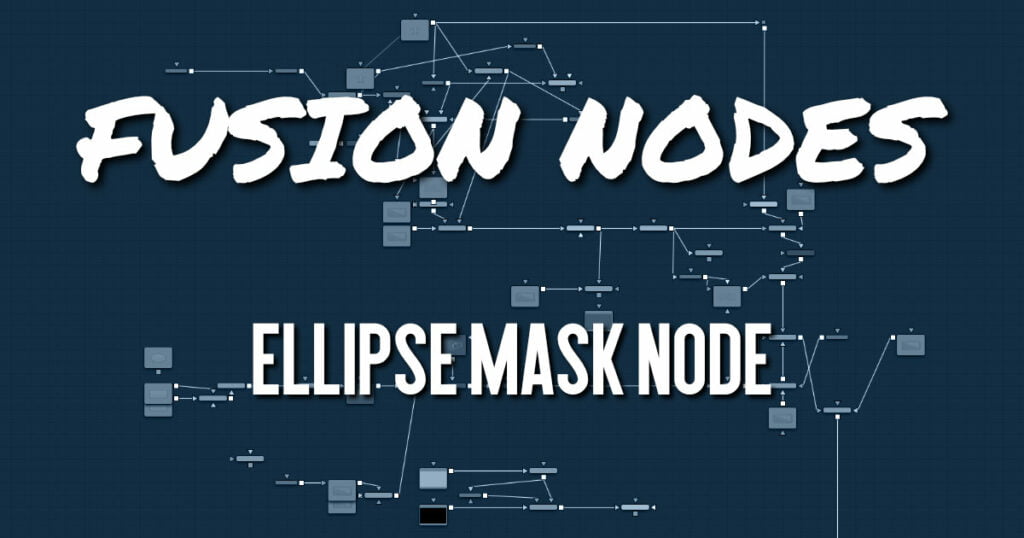
The Ellipse mask is most useful for masking round objects. It is a circle by default, but independent control is offered over the width, height, and angle, providing for a wide variety of ellipsoidal shapes.
Ellipse Mask Node Inputs
The Ellipse mask node includes a single effect mask input.
- Effect Mask: The optional blue input expects a mask shape created by polylines, basic primitive shapes, paint strokes, or bitmaps masks. Connecting a mask to this input combines the masks. How masks are combined is handled in the Paint mode menu in the Inspector.
Ellipse Mask Node Setup
The Ellipse mask node is useful for generating circular masks. Below, the Ellipse mask is used to generate a circular colored shape by cutting a circular shape from a background node.
Ellipse Mask Node Controls Tab
The Controls tab is used to refine how the ellipse appears after drawing it in the viewer.
Show View Controls
The Show View Controls checkbox is used to enable/disable the display of the mask’s onscreen controls in the viewer. Onscreen controls, including center position, polylines, angles, and others, do not appear when this checkbox is disabled, even when the node is selected.
Level
The Level control sets the transparency level of the pixels in the mask channel. When the value is 1.0, the mask is completely opaque (unless it has a soft edge). Lower values cause the mask to be partially transparent. The result is identical to lowering the blend control of an effect.
Filter
This control selects the filtering algorithm used when applying Soft Edge to the mask.
- Box: This is the fastest method but at reduced quality. Box is best suited for minimal amounts of blur.
- Bartlett: Otherwise known as a Pyramid filter, Bartlett makes a good compromise between speed and quality.
- Multi-box: When selecting this filter, the Num Passes slider appears and lets you control the quality. At 1 and 2 passes, results are identical to Box and Bartlett, respectively. At 4 passes and above, results are usually as good as Gaussian, in less time and with no edge “ringing.”
- Gaussian: The Gaussian filter uses a true Gaussian approximation and gives excellent results, but it is a little slower than the other filters. In some cases, it can produce an extremely slight edge “ringing” on floating-point pixels.
Soft Edge
Use the Soft Edge slider to blur (feather) the mask, using the selected filter. Higher values cause the edge to fade off well beyond the boundaries of the mask. A value of 0.0 creates a crisp, well-defined edge.
Border Width
The Border Width control adjusts the thickness of the mask’s edge. When the solid checkbox is toggled on, the border thickens or narrows the mask. When the mask is not solid, the mask shape draws as an outline, and the width uses the Border Width setting.
Paint Mode
Connecting a mask to the effect mask input displays the Paint mode menu. The Paint mode is used to determine how the incoming mask for the effect mask input and the mask created in the node are combined.
- Merge: Merge is the default for all masks. The new mask is merged with the input mask.
- Add: The mask’s values add to the input mask’s values.
- Subtract: In the intersecting areas, the new mask values subtract from the input mask’s values.
- Minimum: Comparing the input mask’s values and the new mask, this displays the lowest (minimum) value.
- Maximum: Comparing the input mask’s values and the new mask, this displays the highest (maximum) value.
- Average: This calculates the average (half the sum) of the new mask and the input mask.
- Multiply: This multiplies the values of the input mask by the new mask’s values.
- Replace: The new mask completely replaces the input mask wherever they intersect. Areas that are zero (completely black) in the new mask do not affect the input mask.
- Invert: Areas of the input mask that are covered by the new mask are inverted; white becomes black and vice versa. Gray areas in the new mask are partially inverted.
- Copy: This mode completely discards the input mask and uses the new mask for all values.
- Ignore: This mode completely discards the new mask and uses the input mask for all values.
Invert
Selecting this checkbox inverts the entire mask. Unlike the Invert Paint mode, the checkbox affects all pixels, regardless of whether the new mask covers them or not.
Solid
When the Solid checkbox is enabled, the mask is filled to be transparent (white) unless inverted. When disabled, the spline is drawn as just an outline whose thickness is determined by the Border Width slider.
Center X and Y
These controls adjust the position of the Ellipse mask.
Width
This control allows independent control of the ellipse mask’s Width. In addition to the slider in the mask’s controls, interactively drag the width (left or right edge) of the mask on the viewer using the pointer. Any changes will be reflected in this control.
Height
Height allows independent control of the ellipse mask’s height. In addition to the slider in the mask’s controls, interactively drag the height (top or bottom edge) of the mask on the view using the pointer. Any changes will be reflected in this control.
To change the mask’s size without affecting the aspect ratio, drag the onscreen control between the edges (diagonal). This will modify both the width and height proportionately.
Angle
Change the rotational angle of the mask by moving the Angle control left or right. Values can be entered into the number fields provided. Alternately, use the onscreen controls by dragging the little circle at the end of the dashed angle line to interactively adjust the rotation of the ellipse.
Ellipse Mask Node Image and Settings Tabs
The Image and Settings tabs in the Inspector are also duplicated in other mask nodes. These common controls are described in detail HERE.



